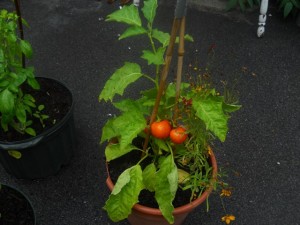Agriculture
Interstate Poultry School

"Interstate poultry husbandry?" That could get you ten to twenty years in prison nowadays!
Original ad here.
Posted By: Paul - Sun Mar 17, 2013 -
Comments (6)
Category: Agriculture, Animals, Education, 1920s
Onion As Weather Forecaster
No, we are not talking about the brilliant humor publication, The Onion. Rather, we are interested in this bizarre bit of folk wisdom: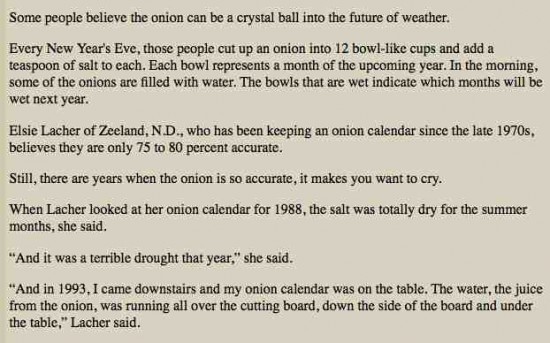
Here's another account, whose hero is depicted below, with greater details as to the proper procedure.
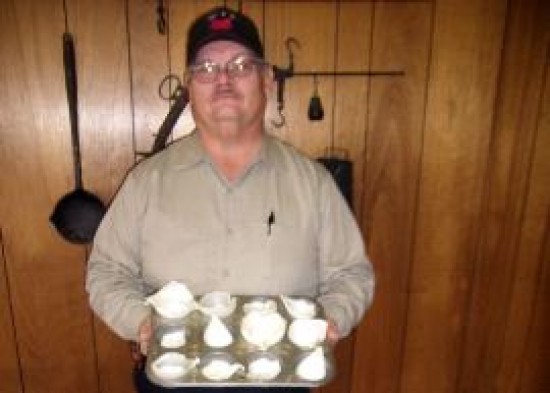
How long has this been going on? At least seventy years, as we can see from this account.
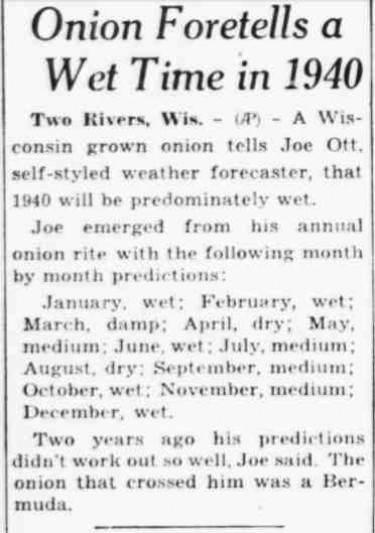
Has anyone ever heard of this before, or know of the origin of the practice?
Posted By: Paul - Tue Sep 25, 2012 -
Comments (9)
Category: Agriculture, Regionalism, Superstition, Vegetables
Grazing Management Basics
More boring than "Wooden Bridge Inspection"? You be the judge!
Posted By: Paul - Mon Jun 18, 2012 -
Comments (3)
Category: Agriculture, Boredom, PSA’s, Regionalism
Innovations in Haystack Slicing
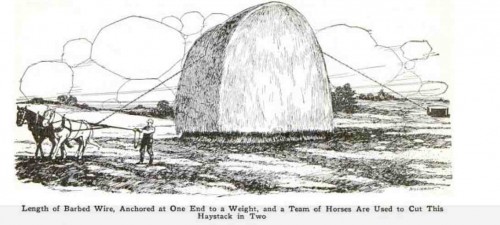
[Click image to enlarge]
I readily confess to being a total city boy. But I still have to ask: would it not have been simpler to make smaller haystacks in the first place?
Or is this just something country folks do for fun?
Original article here.
Posted By: Paul - Thu Feb 16, 2012 -
Comments (7)
Category: Agriculture, Chindogu, 1930s
Johnson Smith Catalog Item #15

[Click to enlarge]
What's good for pigs is good for people!
From the 1950 catalog.
Posted By: Paul - Mon Dec 12, 2011 -
Comments (3)
Category: Agriculture, Animals, Injuries, Johnson Smith Catalog, 1950s, Pranks
Another Helping of Food Related Weirdness – 7
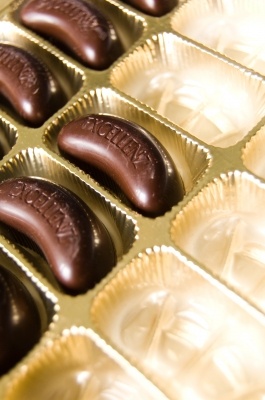
Meanwhile, here is someone who is taking the chocolate maker’s art way too literally. Jean Zaun of Fredericksburg in Pennsylvania uses a mixture of dark and white chocolate, food colouring and confectioner’s glaze to recreate famous works of art, including the frames, in a deliciously edible form. Her subjects have included the works of Van Gogh, Munch and Da Vinci, as well as a portrait of Ozzy Osborne commissioned by his wife. While the chocolate artworks are edible, Zaun believes they should be souvenirs rather than snacks. “They are meant to be consumed by the eye, not the stomach.” Zaun Explained (Daily Mail).
And the misuse of materials won’t stop there, at least not if Dr. Peter Eisner of the Fraunhofer Institute gets his way. Concerned that meat consumption is both unhealthy and bad for the environment, Dr. Eisner has started looking for ways to supplement or replace animal products with vegetable equivalents. His first success is a milk substitute derived from lupins that can even be used to make cheese, meanwhile co-worker Daniela Sussmann has extracted a protein from the seeds gives low-fat sausages more of the sensation of their unadulterated competition. Eisner reckons that our ever growing appetite for meat could one day be disastrous, arguing that the resources needed to produce 1 kilo of meat could instead yield 80 to 100 kilos of fruit or vegetables (Softpedia).
More in extended >>
Posted By: Dumbfounded - Mon Jan 10, 2011 -
Comments (7)
Category: Agriculture, Animals, Farming, Art, Food, Bacon, Candy, Junk Food, Nutrition, Vegetables
It’s Not What You Think
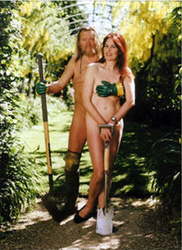
Posted By: Nethie - Fri Oct 15, 2010 -
Comments (14)
Category: Agriculture, Domestic, Nature, Farming
Mystery Vegetable
What is this mystery plant growing in a pot in my driveway?Make your guess, then find out after the jump!
More in extended >>
Posted By: Paul - Fri Aug 06, 2010 -
Comments (6)
Category: Agriculture, Natural Wonders
Weird Science – From Whales To Sails

Sperm whales are still the largest animal ever to have teeth, but today their diet consists mostly of squid – including the infamous giant squid – and therein lies a problem. Whereas most land dwelling creatures live on plant material, or some juicy meaty derivative thereof, and hence are essentially “carbon-neutral”, marine animals from penguins to whales feast upon carbon that was probably sequestered in the oceans hundreds if not thousands of years ago, or has weathered out of rocks that are millions of years old. One upshot of this is that carbon dating is notoriously inaccurate on marine organisms, what scientists call the “reservoir effect”, another is that unlike water breathers such as fish, who return this carbon to the oceans, air breathing animals like whales will release this carbon to the atmosphere as CO2 and so contribute to global warming. However in new research published by the Royal Society of London, researchers have calculated that whales have actually offset their carbon emissions with emissions of another kind. Whale poop is iron rich and comparatively liquid, hence returns the excess iron in the whale’s diet back to the oceans in a form that is readily usable by phytoplankton. The team, led by Trish Lavery of Flinders University in Australia, estimate that sperm whales are responsible for removing 200,000 more tonnes of carbon from the atmosphere annually than they actually emit (Royal Society).
But it’s not all good news for the tree-huggers for while whales might be a boon in the fight against climate change, their free-range, organic farming practices of preference are almost certainly not. In a paper published by the National Academy of Sciences, Jennifer Burney of Stanford University and her colleagues have found that intensive farming is by far the most land and carbon efficient method of agriculture. Because agricultural land use is a major contributor to global warming, increasing the yields from farmland, and thereby reducing the amount of land farmed, strongly outweighed the extra carbon emissions of the intensive farming needed to achieve this. Doing the sums on farm outputs since 1961, the team found that increased yields have produced the same as cultivating an additional area the size of Russia at 1961 levels, which would have led to the release of 590 billion more tonnes of CO2, equal to about a third of all man-made emissions since the industrial revolution (PNAS).
And modern farming may be coming to our rescue in another way, as a source of cheap batteries. Almost since Ben Franklin gave up kite-flying, kids in schools the world over have been making batteries out of apples or a potatoes. Now a trio of researchers from the Hebrew University of Jerusalem, led by Alex Goldberg, have found a way to turn these vegetable power sources from classroom curiosities into a viable product. What’s more amazing is the method they discovered to generate a tenfold increase the output of their potato power-pack, they boil the potato first. How did no-one think of this before (AIP)?
Another new idea, albeit a less welcome one, is that one should prosecute scientists for not knowing everything. At least that seems to be the approach taken by the public prosecutors of the Italian city of L’Aquilla, which last year was hit unexpectedly by an earthquake that killed over 300 people and injured 1600 more. The defendants include the head of Italy’s National Institute of Geophysics and the director of the National Earthquake Center along with four other equally prominent scientists and Bernardo De Bernardinis then deputy head of the Civil Protection Agency, who together are looking at being tried for manslaughter for not alerting the population to the imminent disaster at a meeting held one week before the quake struck. It was Bernardinis, a government official, who claimed in a press conference held immediately after the meeting that the scientists had said there was “no danger”, despite the minutes of the meeting clearly showing that at no time was the chance of a major shock ever ruled out (Nature).
More in extended >>
Posted By: Dumbfounded - Fri Jul 02, 2010 -
Comments (7)
Category: Agriculture, Animals, Dinosaurs and Other Extinct Creatures, Farming, Disasters, Exercise and Fitness, Food, Government, Health, Nature, Natural Resources, Science, Psychology, Excrement
Weird Salt & Pepper Shakers
My brother Bob found these salt and pepper shakers in a junk store and could not resist buying them. Two women with Marge-Simpson hairdos in the form of carrot and corn prepare to engage in fisticuffs.Can anyone explain the iconography here? Note that they do originate in Japan, source of much strangeness.
Posted By: Paul - Sun Apr 25, 2010 -
Comments (5)
Category: Agriculture, Art, Surrealism, Domestic, Interior Decorating, Collectors, Asia

| Who We Are |
|---|
| Alex Boese Alex is the creator and curator of the Museum of Hoaxes. He's also the author of various weird, non-fiction, science-themed books such as Elephants on Acid and Psychedelic Apes. Paul Di Filippo Paul has been paid to put weird ideas into fictional form for over thirty years, in his career as a noted science fiction writer. He has recently begun blogging on many curious topics with three fellow writers at The Inferior 4+1. Contact Us |

